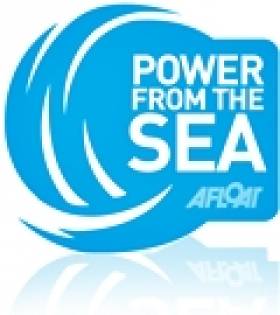Displaying items by tag: Arklow Bank Wind Farm
RV Tom Crean Makes Maiden Call to Dublin Port this Evening
Following a commissioning and naming ceremony of RV Tom Crean in Dingle Harbour, Co. Kerry, Ireland's newest research vessel made its maiden port of call to Dublin Port this evening, writes Jehan Ashmore
The Marine Institute's state-of-the-art multi-purpose €25m newbuild RV Tom Crean was tracked by Afloat.ie today at 1400hrs when offshore of Kilcoole, Co. Wicklow having sailed along Arklow Bank and beforehand in waters south of the Wexford coast.
About an hour earlier today (at lunchhour) it is believed a lighting strike took place at an offshore wind turbine on Arklow Bank as Afloat reported with smoke billowing from the 3.6MW turbine of the renewable energy facility.
The Arklow Bank Wind Farm completed in 2004 consists of seven turbines generating 25.2MW and the facility remains the first and only offshore wind farm in Ireland.
The turbine incident comes when Met Éireann issued early in the afternoon a Status Orange 'thunderstorm' warning for counties Dublin, Kildare, Louth, Meath and Wicklow, with warning of "intense" lightning strikes which was in effect up to 1700hrs this afternoon.
Afloat has since caught up with the Spanish built RV Tom Crean as this evening the vessel approached Dublin Bay where coastal weather conditions in this part of the Irish Sea to Hook Head, is for east to southeasterly force 6 or 7 and occasionally reaching gale force 8 and with isolated thunderstorms.
The 55.8m ship is designed to operate in harsh conditions and was originally scheduled to be in Dublin Bay at 19.30hrs but was delayed by about two hours.
It was around 20.30hrs when off the Dublin Bay bouy the pilot cutter DPC Dodder (introduced in March) came alongside the newbuild to transfer a pilot on board. By that stage the wind had reduced compared to the afternoon.
At approximately 20.55hrs RV Tom Crean passed between the lighthhouses of Dublin Port which marked a significant moment for the Irish flagged newbuild's debut to the capital.
A berth at Sir John Rogerson's Quay has been allocated within the old 'Docklands' quarter close to the city-centre with the RV Tom Crean to head up this stretch of the river Liffey. This can only be reached through the relative confines of the Tom Clarke (East-Link) toll lift-bridge which the newbuild achieved by 21.20hrs.
Following this the RV Tom Crean swung around completely on the Liffey so to come alongside the south quay and berth at around 21.30hrs.
With the RV Tom Crean in service the Marine Institute can undertake cutting edge scientific surveys that deepen an understanding of the ocean and place Ireland as a leader in marine science.
The design for the new research vessel named after the Kerry born Antartic polar explorer was tasked to Norwegian ship design consultants Skipsteknisk AS of Ålesund. As for a shipbuilding order the contract went to the Spanish shipyard of Astilleros Armon Vigo S.A.
In July the RV Tom Crean made a maiden delivery voyage to the newbuild's homeport of Galway from where it will be based to undertake fisheries research, oceanographic and environmental research, seabed mapping surveys.
Other roles include maintaining and deploying weather buoys, observational infrastructure and the deployment of (ROV) Remotely Operated Vehicles.
As for the duration of the maiden call to Dublin Port, the visit will be short as the ship is scheduled to remain in port for 24 hours or possibly less given this evening's late arrival.
#POWER FROM THE SEA - This morning the wind farm turbine installation vessel Sea Energy, departed Wicklow Bay having spent over a fortnight based in Wicklow Port, where her Danish crew celebrated Christmas Day, writes Jehan Ashmore.
The Esbjerg registered vessel operated by A2 Sea, arrived in the week before Christmas to work at Airtricity's Arklow Bank Wind Farm, but the nature of the work was based on internal operations only at the seven turbine facility, which each structure scaling to a height of over 70 metres / 240 feet.
Upon completion of her work, she returned to Wicklow where her crew spent the festive season in port with a Christmas tree complete with lights! at the bow.
She remained in the harbour into the New Year and during the recent spate of heavy weather until finally departing yesterday on Little Christmas, where she overnighted in the bay.
With four towering supporting jack-up legs each 32 metres high, this enables her to carry out offshore crane operations with greater control. In addition the vessel is raised completely above the water to gain elevation to assist mounting the pre-assembled wind-turbine components from her deck cargo.
She can work in waters of up to 24 metres and as she rests on the sea-bed this provides a more stable working platform.
Sea Energy presented a distinctive profile while in port as she 'sat' close to the Packet Quay, as her jack-up legs make mooring ropes redundant.
The quay is the main commercial quay and during this week she vacated the berth to allow regular caller Scot Isles (2001/2,595grt) which arrived with a cargo of sawn packaged timber products from Scandinavia. Owned by Scot Line, the vessel remained in the port for two days and then departed for Warrenpoint.
The Wicklow Port Company also specialise in dry-cargoes, lead, and scrap-metal as previously reported, to read more click HERE.
It is somewhat unusual for vessel movements in Wicklow to berth outside the harbour piers, as in the case with Sea Energy.
She shifted berths to the seaward side of the West Pier and again she sat with jack-legs lowered in water depths of six metres, leaving a clearance of around two metres below the keel.
Although Arklow is closer to the wind-farm than Wicklow, Sea Energy's 3,332 gross tonnes is too large to be accommodated as the port on the River Avoca has a has lower water depth.






























































